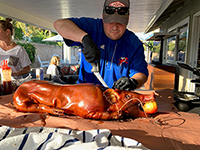It’s April, and baseball season is in full swing — for most of us anyway. This author would argue that a sport with a pitch clock, no infield shifts, a three-batter minimum for relief pitchers, a free runner on second base in extra innings, and full adoption of the designated hitter is not the same sport it used to be.1
But when it comes to baseball memorabilia, there’s something that hasn’t changed: You’ll be hit with a tax bill if you sell a home run ball.
New York Yankees slugger Aaron Judge broke the American League’s single-season home run record last year, and estimates put the ball’s value between $1 million and $2 million.2 According to former Treasury employee Michael J. Graetz, recognizing the ball as ordinary income would mean a tax bill of at least $332,955. And former IRS chief counsel Donald Korb’s position is that if a fan keeps a ball for more than a year before selling, it would be treated as a collectible and taxed at 28%.
Believe it or not, the IRS’s stance up until 1998 was that even giving a ball away — including simply returning it to a player who hit a home run — would trigger a tax bill. But that all changed in 1998 with the home run race between Mark McGwire and Sammy Sosa.3
Charles Rossotti, the IRS Commissioner at the time, said, “All I know is that the fan who gives back the home run ball deserves a round of applause, not a big tax bill.”
And believe it or not, members of Congress from both sides of the aisle actually agreed! Today that sounds as foreign as a pitcher stepping into the batter’s box.






